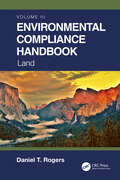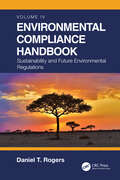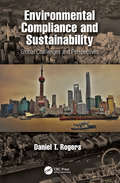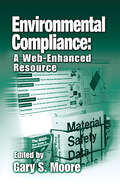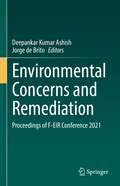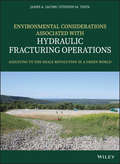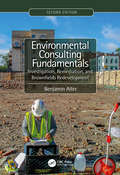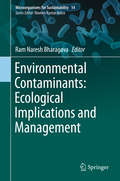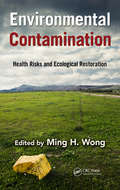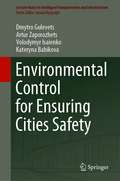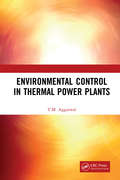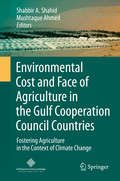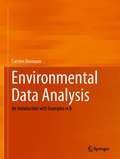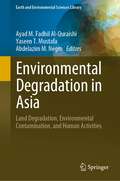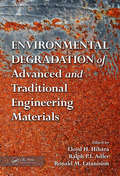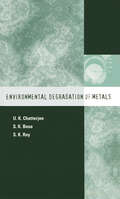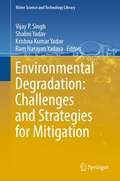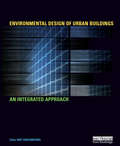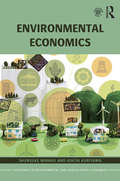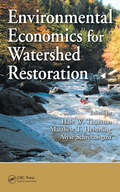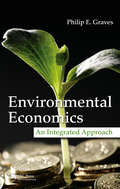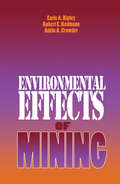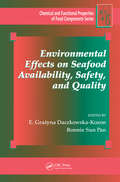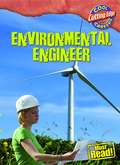- Table View
- List View
Environmental Compliance Handbook, Volume 3: Land
by Daniel T. RogersEnvironmental laws and regulations are extremely complex and difficult to understand. In order to comply with them, they need to be explained in layperson’s terms. The handbook identifies many changes in regulations and recommends ways to apply and implement them. Containing the latest environmental information, this third volume addresses environmental compliance with land and provides a historical perspective to help follow the logical growth and increased complexity of land regulations through time. Structured as a “step-by-step how-to” book, readers will find real-life examples for the most important aspects of language, permit terms, demonstrating compliance, and organization for land projects. Features: Introduces all land pollution control regulations and the requirements of any land pollution control permits available up to date Answers in depth all practical questions that arise when working on compliance projects in a "how-to" method Addresses a wider spectrum of issues that go beyond chemical-based contamination and environmental regulations and examines the impacts of climate change Includes many real-life examples and case studies from industry and institutions that comply with land use regulations It is global in coverage and very useful to companies that have expanded operations outside their country of origin
Environmental Compliance Handbook, Volume 4: Sustainability and Future Environmental Regulations
by Daniel T. RogersEnvironmental laws and regulations are extremely complex and difficult to understand. In order to comply with them, they need to be explained in layperson’s terms. This handbook identifies many changes in regulations and recommends ways to apply and implement them. Containing the latest environmental information, this volume goes beyond environmental regulations in two fundamental aspects: sustainability and preparation for future requirements before mandates are enacted. Structured as a “step-by-step how-to” book, readers will find real-life examples for the most important aspects of evaluating sustainability initiatives and preparing for new and revised environmental regulations. Features: Explores all sustainability related concepts and regulations and the requirement of any control permits available up to date. Answers in depth all practical questions that arise when working on compliance projects for future requirements. Addresses a wider spectrum of sustainability issues that go beyond chemical-based contamination and environmental regulations and examines the impacts of climate change. Includes many real-life examples and case studies from industry and institutions that comply with sustainability regulations. It is global in coverage and very useful to companies that plan to expand operations outside their country and are interested in future regulations.
Environmental Compliance and Sustainability: Global Challenges and Perspectives
by Daniel T. RogersThis book provides a critical understanding of the challenges that exist in protecting the local and global environment through compliance efforts using existing environmental regulations. The best compliance measures with the most useful regulations from over 50 countries are surveyed and are combined with science-based quantitative analysis of geology, hydrogeology, and the chemistry of contaminants from anthropogenic sources. The results are presented as a model that establishes a means by which protection of the environment can be greatly improved. This is accomplished through a deeper understanding of our natural world and how anthropogenic activities and their management affect our planet. Features The first book that examines the successes of environmental regulation worldwide and highlights the areas that need improvement Presents a tested and verified scientific model for enhanced environmental protection with scalability from local parcels to global levels Describes and integrates the importance of understanding the geologic and hydrogeologic environment of urban and developed areas Explains the importance of understanding the different types of pollution and their behavior in the environment Identifies the need for consistency in banning chemicals that are harmful in not just one country but throughout the world
Environmental Compliance: A Web-Enhanced Resource
by Gary S. MooreSTAY INFORMED-STAY COMPLIANT-STAY UP-TO-DATEYou can't do business in the United States without complying with a whole new generation of environmental regulations. Get all the information you need with Environmental Compliance: A Web-Enhanced Resource. This resource will never be outdated. With the continually updated Web site, you will alwa
Environmental Concerns and Remediation: Proceedings of F-EIR Conference 2021
by Jorge De Brito Deepankar Kumar AshishThis book presents the conference proceedings of the F-EIR Conference 2021, Environment Concerns and its Remediation held in Chandigarh, India, October 18–22, 2021. The purpose of the conference and the volume is to present new ideas across a range of disciplines in environmental science, with a focus on theoretical and practical approaches to clean production aimed at preventing the production of waste, while increasing efficiencies in the uses of energy, water, and renewable resources. With contributions from leading experts equipped with state-of-the-art information and technology, the book covers topics of sustainability and resilience, chemical and environmental engineering, materials science, biotechnology, health-related microorganisms, and green technologies. The book will be of interest to scientists, engineering professionals, architects, environmental scientists, academicians, economists, and students engaged in these disciplines.
Environmental Considerations Associated with Hydraulic Fracturing Operations: Adjusting to the Shale Revolution in a Green World
by James A. Jacobs Stephen M. TestaA guide to environmental and communication issues related to fracking and the best approach to protect communities Environmental Considerations Associated with Hydraulic Fracturing Operations offers a much-needed resource that explores the complex challenges of fracking by providing an understanding of the environmental and communication issues that are inherent with hydraulic fracturing. The book balances the current scientific knowledge with the uncertainty and risks associated with hydraulic fracking. In addition, the authors offer targeted approaches for helping to keep communities safe. The authors include an overview of the historical development of hydraulic fracturing and the technology currently employed. The book also explores the risk, prevention, and mitigation factors that are associated with fracturing. The authors also include legal cases, regulatory issues, and data on the cost of recovery. The volume presents audit checklists for gathering critical information and documentation to support the reliability of the current environmental conditions related to fracking operations and the impact fracking can have on a community. This vital resource: Contains the technical information and mitigation recommendations for safety and environmental issues related to hydraulic fracturing Offers an historical overview of conventional and unconventional oil and gas drilling Explains the geologic and technical issues associated with fracking of tight sand and shale formulations Presents numerous case studies from the United States EPA and other agencies Discusses issues of co-produced waste water and induced seismicity from the injection of wastewater Written for environmental scientists, geologists, engineers, regulators, city planners, attorneys, foresters, wildlife biologists, and others, Environmental Considerations Associated with Hydraulic Fracturing Operations offers a comprehensive resource to the complex environmental and communication issues related to fracking.
Environmental Consulting Fundamentals: Investigation, Remediation, and Brownfields Redevelopment, Second Edition
by Benjamin AlterThis book is a primer for those interested in a career in this dynamic, multidisciplinary field as well as a handy reference for practicing consultants. Combining theory and practice advice into a concise, readable format, the book is an accessible introduction to the types of projects you will encounter as an environmental consultant and lays the groundwork for what you’ll need to know in this challenging and rewarding profession. Also available with this book, under the Additional Resources tab, are PowerPoint lectures that correspond with each chapter. New in the Second Edition Covers the latest environmental issues, including emerging contaminants, and the latest technological advances in environmental investigation and remediation New chapters dedicated to vapor intrusion investigation and mitigation and to Brownfields redevelopment and project financing. An expanded chapter describing the staffing, budgeting, and execution of environmental projects. Descriptions of the remediation processes under RCRA and Superfund Descriptions on how each chapter’s subject matter applies to the job of the environmental consultant. Dozens of new figures, photographs, and tables designed to enhance the reader’s understanding of the subject matter. Problems and questions to be used for homework assignments or classroom discussions.
Environmental Contaminants: Ecological Implications and Management (Microorganisms for Sustainability #14)
by Ram Naresh BharagavaAs we know, rapid industrialization is a serious concern in the context of a healthy environment. Various physico-chemical and biological approaches for the removal of toxic pollutants are available, but unfortunately these are not very effective. Biological approaches using microorganisms (bacterial/fungi/algae), green plants or their enzymes to degrade/detoxify environmental contaminants such as endocrine disrupting chemicals, toxic metals, pesticides, dyes, petroleum hydrocarbons and phenolic compounds are eco-friendly and low cost. This book provides a much-needed, comprehensive overview of the various types of contaminants, their toxicological effects on the environment, humans, animals and plants as well as various eco-friendly approaches for their management (degradation/detoxification). As such it is a valuable resource for a wide range of students, scientists and researchers in microbiology, biotechnology, environmental sciences.
Environmental Contamination: Health Risks and Ecological Restoration
by Ming H. WongBringing together the research of 62 distinguished scientists in one volume, Environmental Contamination: Health Risks and Ecological Restoration offers a comprehensive view of the remediation of contaminated land. A one-stop resource, it covers historical and emerging contaminants, the issues of bioavailability of chemicals and their associated hu
Environmental Control for Ensuring Cities Safety (Lecture Notes in Intelligent Transportation and Infrastructure)
by Volodymyr Isaienko Artur Zaporozhets Dmytro Gulevets Kateryna BabikovaThis proceedings book is devoted to the development of environmental analysis of the surface layer of atmospheric air and green areas of urbanized areas. The analysis of scientific and methodological developments for assessing the level of environmental safety of urbanized areas, taking into account the influence of chemical and physical factors, is carried out. The choice of criteria for assessing the ecological state of the surface layer of atmospheric air is theoretically substantiated. The hazard index of the surface layer of atmospheric air, taking into account the influence of chemical and physical factors, and a method of its visual representation are proposed. An assessment of the environmental risk of the influence of the surface layer of the atmosphere was carried out. A quantitative assessment of the energy balance of the green zone is carried out for Kyiv city (Ukraine). Schemes for informing the population about the ecological state of air in real time are developed. The book is for researchers, engineers, as well as lecturers and postgraduates of higher education institutions dealing with issues of atmospheric pollution, ecological safety and urbanization.
Environmental Control in Thermal Power Plants
by T.M. AggarwalFrom wood and coal to predominantly oil and natural gas. Thermal Power Plants use fuels for power generation. Water is used for process, cooling, as well as for service/drinking requirement. Chemicals are used for conditioning of water, corrosion-control and sometimes for conditioning of fuel as well. Lubricants are used for machinery. These inputs generate waste products. Human related wastes (sewage etc.) are also generated along with the processed waste. These pollutants/wastes need to be treated before their disposal from the plants. The treated effluents are required to meet the limits set by Central / State Pollution Control Boards. The regulations, issued by these agencies, specify the maximum allowable limits applicable to the pollutants discharge from the Power Plants. This book is a serious effort that deals in detail with all the above issues and we are sure that scientists, academicians, researchers and professionals who are constantly facing these issues and are striving to move towards a zero emission regime, will find this monograph a very useful reference tool on the topic.Note: T&F does not sell or distribute the Hardback in India, Pakistan, Nepal, Bhutan, Bangladesh and Sri Lanka.
Environmental Cost and Face of Agriculture in the Gulf Cooperation Council Countries
by Shabbir A. Shahid Mushtaque AhmedThis volume presents the outcome of an Agriculture Workshop organized by the Gulf Research Centre Cambridge (GRCC) and held at Cambridge University, UK during the Gulf Research Meeting 11-14 July 2012. Co-directed by the editors, the workshop, entitled "Environmental Cost and Changing Face of Agriculture in the Gulf States" was attended by participants from Australia, Bahrain, India, Kuwait, Oman, Saudi Arabia, Turkey, UAE, UK and Morocco. These scientists, educators, researchers, policy makers and managers share their experience in agriculture in the Gulf States, with the aim of helping to improve agriculture production and thus bridge the gap between local production and the food import. The papers gathered here were presented at the workshop and have all passed through rigorous peer review by renowned scientists. The diverse papers present various aspects of agriculture production in the evolving face of climate change and dwindling water resources in the region. The book covers topics such as the prospects of agriculture in a changing climate; the potential of climate-smart agriculture; the impact of food prices, income and income distribution on food security; improved efficiency in water use; challenges in using treated wastewater in agriculture; investment in foreign agriculture and agricultural research and development. The papers span the nations of the Gulf Cooperation Council, with specific case studies set in Oman, Bahrain and Kuwait.
Environmental Data Analysis: An Introduction with Examples in R
by Carsten DormannEnvironmental Data Analysis is an introductory statistics textbook for environmental science. It covers descriptive, inferential and predictive statistics, centred on the Generalized Linear Model. The key idea behind this book is to approach statistical analyses from the perspective of maximum likelihood, essentially treating most analyses as (multiple) regression problems. The reader will be introduced to statistical distributions early on, and will learn to deploy models suitable for the data at hand, which in environmental science are often not normally distributed. To make the initially steep learning curve more manageable, each statistical chapter is followed by a walk-through in a corresponding R-based how-to chapter, which reviews the theory and applies it to environmental data. In this way, a coherent and expandable foundation in parametric statistics is laid, which can be expanded in advanced courses.The content has been “field-tested” in several years of courses on statistics for Environmental Science, Geography and Forestry taught at the University of Freiburg.
Environmental Degradation in Asia: Land Degradation, Environmental Contamination, and Human Activities (Earth and Environmental Sciences Library)
by Abdelazim M. Negm Yaseen T. Mustafa Ayad M. Fadhil Al-QuraishiThis unique book focuses on environmental degradation in Asian countries including land degradation and soil erosion. The land degradation covers assessing environmental degradation using geospatial technology, land use land cover mapping, environmental and anthropogenic degradation, assessment of land degradation vulnerability, evaluation of the impact of earthquake and the environmental control of the sand dunes. It also addresses the soil degradation and environmental pollution and presents several case studies such as tectonic activity and erosion, assessment of aircraft sound, soil degradation assessment for the arid territories, soil pollution, waste engine oil contamination, soil degradation, soil erosion modelling, land use and land cover change and its effect on soil erosion changes. Additionally, the book discusses the impact of climate change, and human activities including urban environmental quality, air pollution and the impact of armed conflict on the environment. Moreover, topics such as vegetation degradation including forest changes, hydrological and agricultural drought are presented. The book includes authors and scientists from Egypt, Iraq, Iran, India, Mongolia, United Arab Emirates, Uzbekistan, Republic of Kazakhstan, USA, Turkey, South Africa, Italy, China, Malaysia, Poland and Russia. Graduate students, researchers, engineers, policy planners, policymakers and stockholders could benefit from the information and the knowledge in this book.
Environmental Degradation of Advanced and Traditional Engineering Materials
by Lloyd H. Hihara Ronald M. Latanision Ralph P.I. AdlerOne of the main, ongoing challenges for any engineering enterprise is that systems are built of materials subject to environmental degradation. Whether working with an airframe, integrated circuit, bridge, prosthetic device, or implantable drug-delivery system, understanding the chemical stability of materials remains a key element in determining t
Environmental Degradation of Metals: Corrosion Technology Series/14 (Corrosion Technology)
by U.K. Chatterjee S.K. Bose S.K. RoyThis highly practical reference presents for the first time in a single volume all types of environmental degradation a metallic compound may undergo during its processing, storage, and service. Clarifying general and localized corrosion effects, Environmental Degradation of Metals describes the effects of atmospheric exposure, high-temperature gas
Environmental Degradation: Challenges and Strategies for Mitigation (Water Science and Technology Library #104)
by Vijay P. Singh Shalini Yadav Ram Narayan Yadava Krishna Kumar YadavThis book discusses problems, challenges, and mitigation strategies in the wake of environmental degradation. It suggests proactive solutions to problems of environmental degradation for strategic planning as well as their effective delivery, and problems arising due to growth in population, industry, and land use change. The uniqueness of the book is its broader spectrum of coverage with related interconnections and interdependence of various aspects. Presenting a wide spectrum of viewpoints and approaches, the book covers topics, such as deforestation impacts (land use and land cover, soil erosion); impacts on climate change and human health; treatment of industrial, municipal, biological waste disposal and their impacts on soil, water, and air; recovery/remediation processes and technologies; impacts of pesticides and chemical fertilizers on soil degradation and groundwater; socio-economic environmental sustainability; and socio-economic health impacts. Particular focus is placed on strategic planning and methodological handling of environmental degradation and remediation through various processes and treatment technologies. This book will be useful to researchers, professionals, policy makers, and environmental engineers.
Environmental Design of Urban Buildings: An Integrated Approach
by Mat SantamourisThis book provides a review of environmental and energy research with respect to urban building projects. It describes how to overcome related challenges in environmental design of urban buildings. The book discusses the passive and active environmental systems within building concepts.
Environmental Economics (Routledge Textbooks in Environmental and Agricultural Economics)
by Shunsuke Managi Koichi KuriyamaThis book aids those concerned about environmental issues to firmly grasp relevant analytical methods and to comprehend the thought process behind environmental economics. It does so by drawing from specific environmental issues and at the same time providing commentary that facilitates understanding. This text contains in-depth explanations necessary for a thorough understanding of the fundamental aspects and importance of environmental economics. Environmental Economics seeks to elucidate the mechanisms that give rise to environmental problems by approaching environmental issues from an economic perspective. At the same time, it is a study aiming to indicate specific countermeasures that could resolve present environmental issues. This text has been put together in way that allows readers without specialized economics knowledge to easily understand the situation, issues and challenges of environmental economics.
Environmental Economics for Watershed Restoration
by Matthew T. Heberling Hale W. Thurston Alyse SchrecongostWhether addressing pollution problems or helping protect a specific use, watershed associations are finding that the competition for funds is getting harder. While we can grasp the value of our streams for fishing or kayaking and other services, or their cultural value, or their value to an ecosystem, putting a dollar value on those benefits is not
Environmental Economics: An Integrated Approach
by Philip E. GravesRigorous, yet written in a way that facilitates understanding of complex material, Environmental Economics: An Integrated Approach provides practical and working knowledge of how environmental policy analysis is developed. This is a true textbook, detailing the tools required to conduct that analysis and also discusses weaknesses in the existing me
Environmental Effects of Mining
by RobertE. RedmannResearch funded by the Centre for Resource Studies,Queen's University, Kingston, Ontario, Canada
Environmental Effects of Transgenic Plants: The Scope and Adequacy of Regulation
by National Research CouncilTransgenic crops offer the promise of increased agricultural productivity and better quality foods. But they also raise the specter of harmful environmental effects. In this new book, a panel of experts examines: • Similarities and differences between crops developed by conventional and transgenic methods • Potential for commercialized transgenic crops to change both agricultural and nonagricultural landscapes • How well the U.S. government is regulating transgenic crops to avoid any negative effects. Environmental Effects of Transgenic Plants provides a wealth of information about transgenic processes, previous experience with the introduction of novel crops, principles of risk assessment and management, the science behind current regulatory schemes, issues in monitoring transgenic products already on the market, and more. The book discusses public involvement—and public confidence—in biotechnology regulation. And it looks to the future, exploring the potential of genetic engineering and the prospects for environmental effects.
Environmental Effects on Seafood Availability, Safety, and Quality (Chemical & Functional Properties of Food Components)
by E. Grazyna Daczkowska-Kozon Bonnie Sun PanAn essential part of diverse marine ecosystems, seafood organisms are especially vulnerable to changes in their natural habitats that affect their reproductive abilities, growth rate, and mutual inter- and intra-species interactions. Environmental Effects on Seafood Availability, Safety, and Quality Issues discusses a variety of factors, both intri
Environmental Engineer (Cool Cutting Edge Careers)
by Geoffrey M. HornHow can we keep our drinking water pure? Whats the best way to dispose of our waste? How can we limit pollution? Answering these questions is the job of environmental engineers. Using the latest technology and research, environmental engineers are changing our world. Learn about the many different jobs that make up this cutting-edge career.
